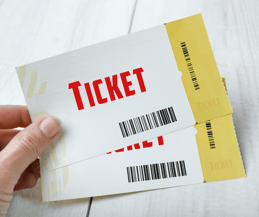How to Sell Ticketmaster Tickets: Easy Step-by-Step Guide
Ticketmaster is one of the biggest event ticketing websites in the world. Not only can you use Ticketmaster to purchase tickets for many events, but you can also use the site to resell tickets that you no longer want. It's a great way to recoup any potential losses and reach a wide audience of people. Listing your tickets is easy, and you can get started with just a few simple steps.
Tip: If you want your tickets to sell faster, consider selling your tickets on Lysted! When you list with Lysted, you automatically list with Ticketmaster, StubHub, Vivid Seats, Gametime, SeatGeek, and all other major marketplaces.
How to Sell Ticketmaster Tickets
1. Choose Event
First, choose the event for which you've bought the tickets. Find it listed on Ticketmaster so that you can select the right option. Not all events or ticket types are approved for resale on Ticketmaster, so it's important to check before you go any further.
2. Create a Ticketmaster Account
A Ticketmaster account will be needed to list your tickets for sale. Setting up an account is fast, and you might already have one if you've bought tickets from the site or app before. Go to "Sign In/Register" on the website or set up an account via the mobile app. You'll need to provide an email address and password to get started.
It's a good idea to complete your seller profile at the same time. This is helpful if the event is canceled and a refund needs to be processed. You will need to add a payment method, submit your seller tax details, and possibly verify your account. Your tax seller details will need to be validated before you can receive any payment.
3. List Tickets
 The next step is to list your tickets for sale. You can list tickets that you've previously purchased from Ticketmaster by selecting them from your account. On the app, tap "Sell" and then "Sell your tickets", and then choose the tickets that you want to sell. On Ticketmaster.com, go to the "My Tickets" section of your account, choose the "Sell Tickets" button, and then select the tickets that you want to list for sale.
The next step is to list your tickets for sale. You can list tickets that you've previously purchased from Ticketmaster by selecting them from your account. On the app, tap "Sell" and then "Sell your tickets", and then choose the tickets that you want to sell. On Ticketmaster.com, go to the "My Tickets" section of your account, choose the "Sell Tickets" button, and then select the tickets that you want to list for sale.
You can also list your tickets by barcode. To do this, find the right event on Ticketmaster's Sell Page and click "Sell" on the app or "Sell Tickets" on the website. Enter the ticket barcodes for the tickets you want to sell, then click continue and follow the steps to finish listing your tickets for sale.
4. Set Selling Price
Part of the process of listing your tickets for sale on Ticketmaster is setting the price. Once you've chosen which tickets you want to sell, follow the steps to choose your pricing and enter a payment method. You might choose to list your tickets at the price you paid for them, or perhaps even a little less if you want them to sell quickly. Alternatively, you could list your tickets above the original asking price. This could work out for you if you know the event is in high demand and has perhaps already sold out. But be careful about setting your prices too high. You want them to sell.
5. Handle Buyer Inquiries
You have the option to accept ticket offers when they're listed for sale. Under the "Sell" or "Sell Tickets" area, you will find an option that says "Sell Tickets Now" if there is an offer waiting for the tickets that you can claim. You can select "View Offer" and then "Accept Offer" to accept the sale. This option will show you how much has been offered, so you can review the offer and make a decision. It's only available for tickets purchased through Ticketmaster, not those listed with the barcode option. Offers can be available for a few days or weeks, or you can choose to reject them.
6. Complete Sale
You will be notified when your tickets sell on Ticketmaster. You don't have to do anything once they've sold. However, it is a good idea to check that you have completed your seller profile. Ticketmaster needs important information to pay you, including the details of your U.S. bank account. You might also need to provide your Social Security Number (SSN), Individual Taxpayer Identification Number (ITIN), or Employer Identification Number (EIN) if you're selling through a business. Be sure to add a payment method too. This might need to be validated before you can receive any payments.
7. Receive Payment
If you bought and sold your tickets from Ticketmaster, you will typically receive your payment within 5-7 days of them being sold. However, if you list them by barcode, you won't get your payment until after the event has taken place.
Add a payment method when you list your tickets to ensure you get paid promptly. If you add your bank details, two small deposits will be used to verify your account. Go to "Billing Information" in your profile and choose "Verify Now" under "Selling Tickets". Alternatively, you can use a U.S. debit card as your payment method.
Ticketmaster will get your tickets seen by a lot of people, but it's just one place to sell them.
There are multiple other ticket-selling marketplaces, such as StubHub and Vivid Seats, where you can get your tickets seen. It’s important not to list your tickets on multiple platforms, due to the risk of double-selling, which can carry heavy fines.
When you use Lysted, your tickets are listed not just on Ticketmaster but on all major marketplaces, and you don’t have to worry about common reselling issues, like double-selling. Sell your tickets with Lysted today!
Disclaimer: This article is about how to sell tickets directly on Ticketmaster, NOT through Lysted. If you plan on listing your tickets through Lysted, this article does not apply to you. Do not list on Ticketmaster (or any other marketplace) directly and also on Lysted, as this may result in double-selling fines from marketplaces.
Related

Step-by-Step Process for Concert Ticket Resales
.png?width=900&name=Blog%20Pictures%20(77).png)

.png?width=900&name=Blog%20Pictures%20(94).png)